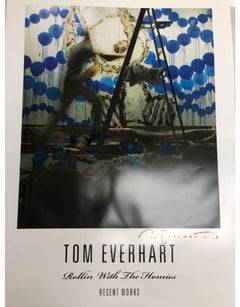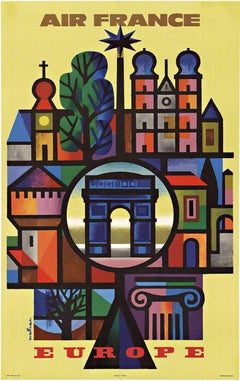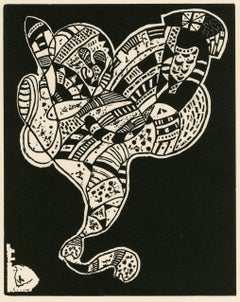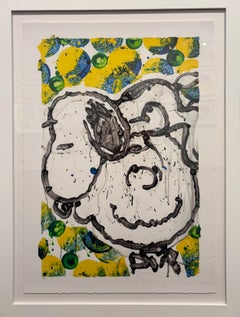Tom Everhart Abstract Prints
American, b. 1952
TOM EVERHART was born on May 21, 1952 in Washington, D.C. He began his under graduate studies at the Yale University of Art and Architecture in 1970. In 1972 he participated in an independent study program under Earl Hoffman at St. Mary’s College. He returned to the Yale School of Art and Architecture in 1974 where he completed his graduate work in 1976, followed by post-graduate studies at the Musee de l’Orangerie, in Paris. He taught Life Drawing and Painting, briefly from 1979 to 1980, at Antioch College.
In 1980, Tom Everhart was introduced to cartoonist Charles M. Schulz at Schulz’s studios in Santa Rosa, California. A few weeks prior to their meeting, Everhart, having absolutely no education in cartooning, found himself involved in a freelance project that required him to draw and present Peanuts renderings to Schulz’s studios. Preparing as he would the drawings and studies for his large-scale skeleton / nature related paintings; he blew up some of the cartoonist’s strips on a twenty-five foot wall in his studio which eliminated the perimeter lines of the cartoon box, leaving only the marks of the cartoonist. Schulz’s painterly pen stroke, now larger than life, translated into painterly brush strokes and was now a language that overwhelmingly connected to Everhart’s own form of expression and communication. Completely impressed with Schulz’s line, he was able to reproduce the line art almost exactly, which in turn impressed Schulz at their meeting. It was directly at this time that Everhart confirmed his obsession with Schulz’s line art style and their ongoing relationship of friendship and education of his line style.
A few years later, while still painting full-time on his previous body of work in his studio, Everhart began drawing special projects for Schulz and United Media, both in New York and Tokyo. These authentic Schulz-style drawings included covers and interiors of magazines, art for the White House, and the majority of the Met Life campaign. When Everhart was not painting, he was now considered to be the only fine artist authorized and educated by Schulz to draw the actual Schulz line.
The paintings using Charles Schulz’s comic strip, Peanuts, as subject matter began and replaced the skeleton and nature related paintings in 1988. The inspiration came to Everhart in Johns Hopkins Hospital, where he was undergoing several operations for stage 4 colon / liver cancer in the summer of 1988. Everhart recalls lying in a hospital bed surrounded by enough flowers to open a florist shop, piles of art books and a stack of Peanuts comic strips sent to him by Schulz. The light streaming in from the window almost projected the new images of his future Schulz inspired paintings on the wall. All the images in Everhart’s work are in some respect derived from Schulz’s Peanuts comic strip.to
1
Overall Width
to
Overall Height
to
1
8
635
207
165
164
1
1
Artist: Tom Everhart
Rollin With the Homies, Recent Works by Tom Everhart (Signed Poster)
By Tom Everhart
Located in Toronto, ON
35" x 24" Unframed
Rolling With the Homies Recent Works Poster
Hand Signed by Tom Everhart
2013
Category
2010s Expressionist Tom Everhart Abstract Prints
Materials
Other Medium
Related Items
Air France Europe original vintage travel poster
By Jacques Nathan-Garamond 1
Located in Spokane, WA
Original AIR FRANCE EUROPE, Editions Perceval, artist: Jacques Nathan Garamond. Professional acid-free archival linen backed vintage travel post...
Category
1960s Expressionist Tom Everhart Abstract Prints
Materials
Lithograph
$1,299
H 39.5 in W 24.5 in
Plate 12
By Wassily Kandinsky
Located in Fairlawn, OH
Plate 12
From: 10 Origi, 1942
Signed in the block with the artist's initials lower left (printed)
From: 10 Origin
Not from the First edition 100, published by Allianz-Verlag, Zurich,...
Category
1970s Expressionist Tom Everhart Abstract Prints
Materials
Woodcut
Eduardo Chillida Spanish Artist Original Unused Lithograph Poster
By Eduardo Chillida
Located in Miami, FL
Eduardo Chillida (Spain, 1924-2002)
'5 Livres Gravés', 1974
Original poster from show
lithograph on paper
25.2 x 17 in. (64 x 43 cm.)
Unframed
Ref: CHI100-202
Eduardo Chillida
He be...
Category
1970s Expressionist Tom Everhart Abstract Prints
Materials
Lithograph
$350
H 25.19 in W 16.92 in
Bernard Lorjou "Pirouette au Galop" 1978 Expressionist Woodcut, Signed, H.C. Edn
By Bernard Lorjou
Located in Miami, FL
BERNARD LORJOU – "PIROUETTE AU GALOP"
⚜ Woodcut ⚜ Hand Signed Lower Left ⚜ Numbered H.C. from the Edition of 80 ⚜ Conservation Frame
ENERGY AND DRAMA FROM “LE CIRQUE”
Created in 197...
Category
1970s Expressionist Tom Everhart Abstract Prints
Materials
Woodcut
Bernard LorjouBernard Lorjou "Pirouette au Galop" 1978 Expressionist Woodcut, Signed, H.C. Edn, 1978
$2,600 Sale Price
35% Off
H 28 in W 33.5 in D 1 in
Original 1979 poster of show "150 Engravings and Lithographies" Madrid Spain
By Pablo Picasso
Located in Miami, FL
"Pablo Ruiz Picasso (Spain, 1881-1973)
'Picasso, 150 grabados y litografías', 1979
Original poster for the exhibition in 1979
lithograph on paper
34.7 x 24.5 in. (88 x 62.2 cm.)
Sign...
Category
1970s Expressionist Tom Everhart Abstract Prints
Materials
Lithograph
$750
H 34.65 in W 24.49 in
Estate No. 082126
By Otto Neumann
Located in New Orleans, LA
Otto Neumann (1895-1975) was an expressionist painter and printmaker born in Heidelberg, Germany. He was one of the most versatile and original artists of...
Category
1960s Expressionist Tom Everhart Abstract Prints
Materials
Monotype
Ecce Homo VII
By Werner Drewes
Located in Fairlawn, OH
Ecce Homo VII
Woodcut, 1921
Signed, titled, and dated in pencil by the artist
One of only three known impressions
Created while the artist was studying at the Bauhaus in Weimar, Germany.
Extreme rarity-One of three know impressions
Note: In 1921 Drewes went to the Bauhaus in Weimar, where, after completing the compulsory preliminary course with Johannes Itten, he continued to study with Paul Klee, Oskar Schlemmer and Georg Muche and initially went to the wall painting workshop. He then traveled extensively through Europe, North America and Asia. After returning to Germany in 1927, he went back to the Bauhaus, this time to his new location in Dessau, where he studied in the classes of László Moholy-Nagy and Wassily Kandinsky. He was one of the first artists to introduce the groundbreaking concepts of the Bauhaus School in the United States through his painting, printmaking, and teaching.
Condition: Excellent
Missing small voids in the upper margin from removal of the original hinges.
Image size: 9 7/8 x 8 3/16 inches
Reference: Rose 30
Provenance: From the estate of Drewes's teacher at the Bauhaus. During the pasot WW2 the professor lived in East Germany.
WERNER DREWES
1899-1985
Werner Drewes initially studied architecture before enrolling, in 1921-22, at the Bauhaus in Weimar under Klee, Kandinsky, Itten and Feininger. For four years - 1923 to 1927 - he travelled the world with his bride, before completing his Bauhaus training in Dessau in 1929. He immigrated to the United States in 1930, documenting that move to New York through series of woodcuts. In 1936/37 he was an active founder of the American Abstract Artists and participated in the Federal Arts Project in New York before moving on to a teaching career at Washington University in St. Louis.
As an artist for over sixty five years, he employed various media from drawing and watercolor, through woodcut and etching, to painting and collage. Translating an early interest in subjective cubistic forms, his work evolved into nonobjective abstraction. He was creative until the day of his death.
Courtesy: Toby C. Moss
Werner Drewes (1899–1985) was a painter, printmaker, and art teacher. Considered to be one of the founding fathers of American abstraction, he was one of the first artists to introduce concepts of the Bauhaus school within the United States. His mature style encompassed both nonobjective and figurative work and the emotional content of this work was consistently more expressive than formal. Drewes was as highly regarded for his printmaking as for his painting. In his role as teacher as well as artist he was largely responsible for bringing the Bauhaus aesthetic to America.
Early life and education
Drewes was born in 1899 to Georg Drewes, a Lutheran pastor, and Martha Schaefer Drewes. The family lived in the village of Canig within Lower Lusatia, Germany. From age eight to eighteen he attended the Saldria Gymnasium, a boarding school in Brandenburg an der Havel. There, he showed talent both for painting and woodblock printing. Graduating from Saldria in 1917, he was drafted by the German army and served in France from then until the close of the war. About this period of his life he is reported to have said that the horrors of life at the front were only made tolerable by his sketchbook, a copy of Goethe's Faust and a volume of Nietzsche.
For a decade following the close of the war he studied, made paintings and prints, and traveled widely. His friend, Herwarth Walden, helped shape his appreciation for expressionist literature and art. Walden produced the quarterly magazine, Der Sturm and ran a gallery of contemporary art, Galerie Der Sturm, from which, in 1919, Drewes purchased an expressionist painting by William Wauer titled Blutrausch (Bloodlust). In the same year he made the acquaintance of Heinrich Vogeler and participated in Vogeler's socialist utopian artists' commune, Barkenhoff, at Worpswede, Lower Saxony. In 1919 Drewes also enrolled at the Königlich Technischen Hochschule Charlottenburg to study architecture and the following year he studied the same subject at the Technischen Hochschule Stuttgart. Preferring art over architecture, he then enrolled in Stuttgart's school of applied arts (Kunstgewerbeschule) where he studied life drawing and learned to work with colored glass. At this time he joined a group of artists and architects associated with the newly formed Merz Akademie, a college of design, art, and media in Stuttgart.
In 1921 his friendship with a French artist, Sébastien Laurent, led him to begin studies in Weimar at Bauhaus, then a new school which taught an integrated approach to the fine and applied arts. His instructors were Johannes Itten and Lyonel Feininger, whose paintings were expressionist and abstract, and Paul Klee, who taught bookbinding, stained glass, and murals. While at Bauhaus Drewes produced a portfolio of ten woodblock prints entitled "Ecce Homo."
In 1923 and 1924 he studied art during travels throughout Italy, Spain, the United States, and Central America and in 1926 he traveled to San Francisco, Japan, and Korea, thence taking the Trans-Siberian railway to Manchuria, Moscow, and Warsaw. He later said the El Grecos he saw proved to be most influential in his work. While traveling, he exhibited: (1) etchings in Madrid (1923) and Montevideo (1924), oils and etchings in Buenos Aires and St. Louis (1925), and (3) etchings in San Francisco (1926). He paid his way by the sales these exhibits produced and by taking commissions to paint portraits. While in San Francisco he set up a shop from which he sold prints he had made in Spain and South America.
After his return to Germany in 1927 he resumed study at Bauhaus, which had been forced to relocate in Dessau, Saxony-Anhalt. His instructors at that time were László Moholy-Nagy (metal work), Wassily Kandinsky, and (painting), and Lyonel Feininger (prints). At this time he also worked and exhibited in Frankfurt. With the rise of Nazism abstract artists found it increasingly difficult to sell their work and, in 1930, Drewes, finding the political pressure unbearable, emigrated to the United States. There, despite the world economic crisis, Drewes was able to earn a living as a professional artist.
Mature style
After Drewes moved to New York, Kandinsky, who was both friend and mentor, continued to exert a strong influence over his style. Later in life he said he had a hard time getting away from Kandinsky's influence as he developed his own style. In time he was able to bring a more emotional approach to his work and to base it, more than Kandinsky did, on natural forms.
In 1930 Drewes had a solo exhibition at the 135th Street Branch of the New York Public Library and a two-person show at the S.P.R. Penthouse Gallery...
Category
1920s Expressionist Tom Everhart Abstract Prints
Materials
Woodcut
Estate No. 082031
By Otto Neumann
Located in New Orleans, LA
Otto Neumann (1895-1975) was a German Expressionist painter and printmaker. His monotypes evolved from sharp, angular, black and whites to late abstract prints in a variety of colors. Neumann lived through revolutionary changes in the art world of prewar and postwar Germany. He was a prolific artist in Germany during a time of the country’s unprecedented academic and intellectual growth. His early work shows the influence of both French masters like Cezanne and the contemporary style that was then being developed by German Expressionists like Kirchner. A master printmaker, Neumann was also inspired by the works of Albrecht Durer, whose allegorical subject-matter and unmatched drawing technique Neumann would emulate throughout his career. A lifetime preoccupation with the human figure informs his work, with frieze-like human figures recalling ancient Greek art...
Category
1960s Expressionist Tom Everhart Abstract Prints
Materials
Monotype
Estate No. 091013
By Otto Neumann
Located in New Orleans, LA
Otto Neumann (1895-1975) was a German Expressionist painter and printmaker. His monotypes evolved from sharp, angular, black and whites to late abstract p...
Category
1960s Expressionist Tom Everhart Abstract Prints
Materials
Monotype
Estate No. 063091
By Otto Neumann
Located in New Orleans, LA
Otto Neumann (1895-1975) was a German Expressionist painter and printmaker. His monotypes evolved from sharp, angular, black and whites to late abstract prints in a variety of colors. Neumann lived through revolutionary changes in the art world of prewar and postwar Germany. He was a prolific artist in Germany during a time of the country’s unprecedented academic and intellectual growth. His early work shows the influence of both French masters like Cezanne and the contemporary style that was then being developed by German Expressionists like Kirchner. A master printmaker, Neumann was also inspired by the works of Albrecht Durer, whose allegorical subject-matter and unmatched drawing technique Neumann would emulate throughout his career. A lifetime preoccupation with the human figure informs his work, with frieze-like human figures recalling ancient Greek art...
Category
1960s Expressionist Tom Everhart Abstract Prints
Materials
Monotype
Estate No. 044059
By Otto Neumann
Located in New Orleans, LA
Signed and dated "55" in pencil.
Otto Neumann (1895-1975) was a German Expressionist painter and printmaker. His monotypes evolved from sharp, angular, black and whites to late abst...
Category
1950s Expressionist Tom Everhart Abstract Prints
Materials
Monotype
Mid century Israeli Expressionist
Located in San Francisco, CA
Bit of a mystery here. Really well done colored Linocut A very expressionistic style of a landscape with trees. I’m pretty sure it’s signed in Hebrew but cannot translate. A very low...
Category
Mid-20th Century Expressionist Tom Everhart Abstract Prints
Materials
Linocut
Previously Available Items
Sleepover Homie Noon
By Tom Everhart
Located in Toronto, ON
31" x 21" Unframed
Limited Edition Giclee Silkscreen on Deckled Paper of 75
Hand Signed by Tom Everhart
Category
2010s Tom Everhart Abstract Prints
Materials
Screen
Reach For The Stars
By Tom Everhart
Located in Toronto, ON
42" x 33" Unframed
Giclee on Paper of 195
Hand Signed by Tom Everhart
Category
2010s Tom Everhart Abstract Prints
Materials
Screen
Tom Everhart abstract prints for sale on 1stDibs.
Find a wide variety of authentic Tom Everhart abstract prints available for sale on 1stDibs. Much of the original work by this artist or collective was created during the 21st century and contemporary and is mostly associated with the Expressionist style. Not every interior allows for large Tom Everhart abstract prints, so small editions measuring 24 inches across are available. Customers who are interested in this artist might also find the work of Otto Neumann, and Wassily Kandinsky. Tom Everhart abstract prints prices can differ depending upon medium, time period and other attributes. On 1stDibs, the price for these items starts at $120 and tops out at $120, while the average work can sell for $120.



